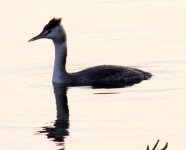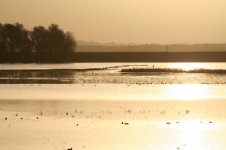Malcolm Stewart
Well-known member
Left Milton Keynes in sunshine, and drove into more and more cloudy weather as we approached the RSPB reserve. This was also my first experience of driving in the Fens off the main road system. Not impressed, excessively bumpy - where do our taxes go? Certainly not here.
Although I thought I understood how the washes work during winter floods, I wasn't prepared to see water extending < all > the way across from the Welches Dam hide to the far bank, about 1km away*. Fully expected to disturb other bird watchers as we entered the hide with my heavy tripod, telescope, camera & lenses, transport trolley etc. I needn't have worried. We were alone, to be joined later by one friendly lady with telescope, binocs and tripod. Around lunchtime we were joined by an extended noisy family, the younger members of which were clearly bored out of their minds so thumped their walking sticks on the floor. The warden popped in and asked if everything was OK. I said nothing.
So what birds did we see, ...?
Tufted duck, black headed gull, mute swan, mallard, immature herring gull(?) and a chaffinch.
...and more importantly, photograph?
None. No bird was remotely close enough for me to waste time setting up my gear.
So we left at around 2pm and went off to the Camera Fair at Cottenham, hoping to find that somehow a Canon EF 1200mm f5.6 might be on offer - it might just have enough reach! The sun was now shining weakly. Got to Cottenham to find that "There is no Camera Fair here today" and that's after a clear announcement in the AP two weeks ago.
So returned to Milton Keynes, somewhat wiser about the Fens, and pleased that here I can get close enough to many birds to get quite reasonable close-ups of them.
*In the hide there were excellent diagrams showing the different states of these washes during the year, and describing their management. For people travelling some distance, like ourselves, it would have been helpful to have this info on the RSPB website, and perhaps updated to indicate just how extensive the floods are.
Although I thought I understood how the washes work during winter floods, I wasn't prepared to see water extending < all > the way across from the Welches Dam hide to the far bank, about 1km away*. Fully expected to disturb other bird watchers as we entered the hide with my heavy tripod, telescope, camera & lenses, transport trolley etc. I needn't have worried. We were alone, to be joined later by one friendly lady with telescope, binocs and tripod. Around lunchtime we were joined by an extended noisy family, the younger members of which were clearly bored out of their minds so thumped their walking sticks on the floor. The warden popped in and asked if everything was OK. I said nothing.
So what birds did we see, ...?
Tufted duck, black headed gull, mute swan, mallard, immature herring gull(?) and a chaffinch.
...and more importantly, photograph?
None. No bird was remotely close enough for me to waste time setting up my gear.
So we left at around 2pm and went off to the Camera Fair at Cottenham, hoping to find that somehow a Canon EF 1200mm f5.6 might be on offer - it might just have enough reach! The sun was now shining weakly. Got to Cottenham to find that "There is no Camera Fair here today" and that's after a clear announcement in the AP two weeks ago.
So returned to Milton Keynes, somewhat wiser about the Fens, and pleased that here I can get close enough to many birds to get quite reasonable close-ups of them.
*In the hide there were excellent diagrams showing the different states of these washes during the year, and describing their management. For people travelling some distance, like ourselves, it would have been helpful to have this info on the RSPB website, and perhaps updated to indicate just how extensive the floods are.





